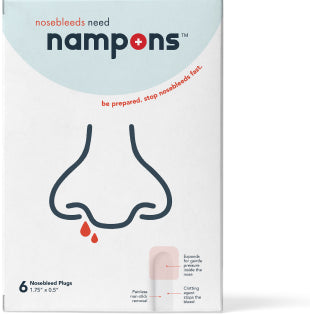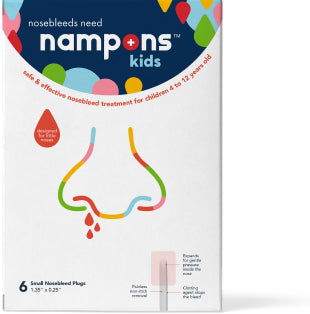Do you see blood on the tissue when you blow your nose? Are there streaks of crimson mixed in with your mucus?
It's quite a common occurrence and there are many possible causes, as well as a few other signs to look out for.
What Causes Mucus With Blood In The Nose?
Nasal mucus is supposed to be clear, but it can take on a few different shades depending on what it's exposed to.
Mucus exists to moisten your nasal passages and trap dust, dirt, and bacteria. If your mucus is green or yellow, it could indicate that you have an infection. If it's red, it likely signifies the presence of blood.
It's normal to feel a little alarmed by the presence of blood in your mucus, but the reality is that most causes are completely innocuous, and minor nosebleeds like this are rarely serious. You likely have more to worry about if your mucus is yellow or green, as it means you could have an infection.
Nosebleeds occur when the small blood vessels in the nose become damaged. They are very delicate and it doesn't take much for them to rupture.
Broken blood vessels can produce varying amounts of blood depending on the extent of the damage and the location. You might have a full nosebleed; you might just lose a few drops that become trapped in your mucus.
The blood vessels in your nose can become damaged as a result of nose blowing, nose picking, exposure to dry air, repeated rubbing, and trauma.
If there are streaks of blood in one nostril, there's usually nothing to worry about. Just refrain from picking your nose, don't blow too hard, and if your nasal cavity is very dry and irritated, apply some petroleum jelly or use a saline spray.
If you are having a full-blown nosebleed, meaning blood is dripping from your nose and not simply present when you blow your nose, you will first need to stop the bleeding before you figure out if you need to see a healthcare professional.
The Proper Way To Stop A Nosebleed
For years people in the US have been stopping nosebleeds with cotton products, such as tissues or toilet paper, whereas doctors, EMTS, nurses, and people in Europe have been using nasal tampons, or Nampons™, which are designed specifically for nosebleeds.
The big difference is that cotton products stick to a cut or wound as the wound is healing. So as you stop a nosebleed with tissues, for example, the tissue fibers get stuck inside the clot that forms. This means that when you remove the tissue, there is at least an 80% chance that you will reopen the clot and the bleeding will start again.
Nasal tampons, on the other hand, are made of non-stick medical gauze, which won't stick to the wound and reopen it when done. Also, since nasal tampons absorb at least 50x more than tissues, you only need one to stop the nosebleed whereas, with tissues, most people report having to constantly swap out the bloody rags (which is also very unsanitary) multiple times.
To properly stop a nosebleed:
- Make sure you have a nasal tampon like Nampons™ always handy in your first aid kit at home, work, or school. Since nosebleeds are rare, a single six-pack will make sure you're covered for a long time.
- Tilt your head forward so the blood does not drip down your throat.
- Insert a Nampon™ into the affected nostril. The nasal tampon will immediately expand to provide gentle pressure on the bleed from inside your nose, therefore slowing the bleed while applying a mild clotting agent.
- After a few minutes, when you feel the bleeding has stopped, simply remove the nasal tampon and dispose of it in the trash. If it's a very heavy bleed, you may need to use a second one.
- Finally, if the bleeding lasts more than 15 minutes, you will want to speak to medical attention as it could be more serious.
Once you have the nosebleed under control, you can now think about what may have caused it. As mentioned, nosebleeds are typically due to an injury, dry air, allergies, medication, or blowing too hard. If none of these seem to be the cause, speak with a healthcare professional.
The nosebleed could also indicate the presence of a sinus infection or other disorder, although such issues would typically present with other symptoms.
Is It OK To Have A Little Blood In Your Mucus?
Whether it's "okay" or not is debatable, as it suggests there is a broken blood vessel somewhere and could also hint at a more serious problem. The vast majority of times, though, a little blood in your mucus is normal.
It's especially common in people who pick their noses (one of the reasons why nosebleeds are more common in young children) and blow their noses with force. It's also more common in people suffering from hay fever, nasal congestion, and other sinus issues, as they are more likely to blow, sniff, snort, rub, and generally irritate their noses.
Does Bloody Mucus Mean a Sinus Infection?
Bloody mucus could indicate the presence of a sinus infection, but it could also hint at many other issues.
A sinus infection can cause the delicate mucus membranes to become dry and damaged. Eventually, the blood vessels will rupture and leak. You may experience full nosebleeds or just notice some streaks/spots of blood in your mucus.
What Does it Mean if My Boogers Are Black?
Do you keep retrieving dark red or black boogers from the deepest recesses of your nose?
First, you should probably leave those boogers where they are. If you're rooting around in your nose, you could be damaging the delicate linings and rupturing the blood vessels, triggering nosebleeds that lead to brown/black snot in the first place.
It's a chicken and egg situation. What comes first, the black snot or the constant picking? Usually, it's the picking. Even if you're 100% confident that you noticed the black boogers before you started picking, there's a good chance you were picking without realizing it and nicked your nose with an errant fingernail.
You may have also caused a small rupture by blowing your nose or repeatedly rubbing it with a tissue. Alternatively, it could be that your nasal membranes are very dry, causing them to crack and rupture.
This is why you may notice more black boogers appearing in very dry air, such as during the winter months when you have the heating on full.
A bloody nose isn't the only cause of dark-colored boogers, though.
It could also indicate the presence of pollutants, which is common in city dwellers and smokers. Alternatively, it could be the result of dirt, ash, dust, and anything else that has found its way into the back of your nose.
If you notice that your snot is brown/black every time you pick, and smoking/pollution isn't an option, consider giving your fingers a rest for a couple of weeks. A little time without any nose-picking or other irritations should be enough for the damaged areas to heal and for your boogers to get back to normal.
If you do cause a nosebleed from picking them out, use a nasal tampon to stop the bleeding and stop picking at them
What Should You Do If You Have Bloody Mucus?
If you have a lot of blood in your mucus, tell your doctor. We can't stress that enough. Indeed, the majority of nosebleeds and cases of bloody mucus are not serious, but it's best to be on the safe side.
For instance, in rare cases, frequent nosebleeds could indicate the presence of tumors and paranasal sinus cancers, although these are usually accompanied by a host of other symptoms.
Heavy nosebleeds, on the other hand, may hint at blood clotting disorders, such as HHT, as well as high blood pressure.
For everything else, the following steps should help to clear the blood away and prevent similar issues in the future.
Stop The Nosebleed
If you have a nosebleed, make sure to stop it the proper way with an FDA-registered OTC product made for nosebleeds, such as Nampons™. You can purchase a package of Nampons™ to keep handy by clicking here.
Clean Your Nasal Passages
A good clean helps to remove all of that blood-streaked mucus and dark-colored snot.
Use a neti pot to flush your sinus or take a long, hot bath/shower so that the steam loosens them.
This is not advised if there is a lot of blood in your mucus and it has only just appeared. That suggests that you have just had a nosebleed, in which case cleaning/steaming could cause a repeat occurrence.
Moisten and Protect
Protect and moisten your delicate mucus membranes using petroleum jelly and nasal sprays. They are unmedicated and designed solely to moisten the area and ensure it stays hydrated.
All you need is a couple of sprays or dabs twice a day, and that should keep the nasal irritation at bay.
Get a Humidifier
Nosebleeds often occur as a result of environmental factors, including dry air. If you live in a very dry climate, you may experience them more often and should consider investing in a humidifier.
Be Gentle
Be very gentle on your nose if you suffer from allergies, sinus problems, or have recently come down with a cold. All of that blowing, picking, and rubbing will cause irritation and ruptures, leading to bloody mucus and/or nosebleeds.
Quit Smoking
Cigarettes irritate the nasal lining and will introduce harmful pollutants to your nose. Not only could this lead to darker-colored boogers, but it may also trigger nosebleeds and cause bloody mucus.
Stay Hydrated
Dehydration dries out your skin and your nasal passages. Drink plenty of water and avoid excessive alcohol consumption.



